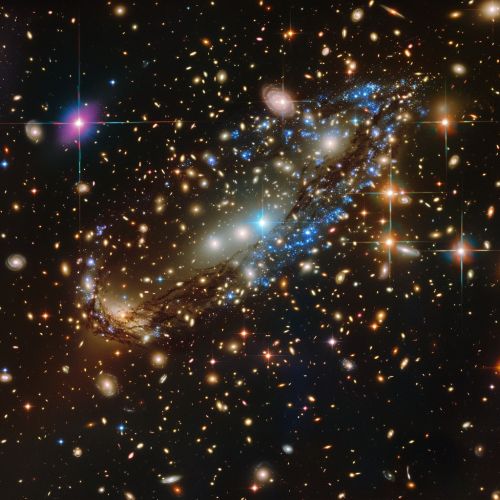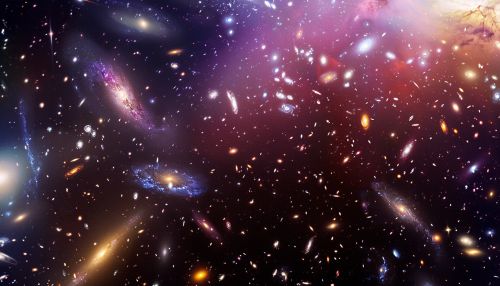Extragalactic Astronomy: Difference between revisions
(Created page with "== Introduction == Extragalactic astronomy is the branch of astronomy that deals with objects outside our Milky Way galaxy. This field encompasses the study of galaxies, galaxy clusters, and the large-scale structure of the universe. It involves understanding the formation, evolution, and properties of these extragalactic objects, as well as their interactions and the role they play in the overall cosmology of the universe. == Historical Backgro...") |
No edit summary |
||
| Line 55: | Line 55: | ||
Galaxy clusters are the largest gravitationally bound structures in the universe, containing hundreds to thousands of galaxies. They are important laboratories for studying galaxy interactions, the intracluster medium, and the effects of dark matter and dark energy on cosmic structure. | Galaxy clusters are the largest gravitationally bound structures in the universe, containing hundreds to thousands of galaxies. They are important laboratories for studying galaxy interactions, the intracluster medium, and the effects of dark matter and dark energy on cosmic structure. | ||
[[Image:Detail-91185.jpg|thumb|center|A visually appealing image of a galaxy cluster with numerous galaxies of various shapes and colors.|class=only_on_mobile]] | |||
[[Image:Detail-91186.jpg|thumb|center|A visually appealing image of a galaxy cluster with numerous galaxies of various shapes and colors.|class=only_on_desktop]] | |||
== Observational Techniques == | == Observational Techniques == | ||
Latest revision as of 10:42, 22 June 2024
Introduction
Extragalactic astronomy is the branch of astronomy that deals with objects outside our Milky Way galaxy. This field encompasses the study of galaxies, galaxy clusters, and the large-scale structure of the universe. It involves understanding the formation, evolution, and properties of these extragalactic objects, as well as their interactions and the role they play in the overall cosmology of the universe.
Historical Background
The field of extragalactic astronomy began to take shape in the early 20th century with the discovery of nebulae that were later identified as galaxies outside the Milky Way. The most notable milestone was Edwin Hubble's discovery in the 1920s that the Andromeda Galaxy was not a nebula within our galaxy but a separate galaxy altogether. This revelation expanded our understanding of the universe and laid the foundation for modern extragalactic astronomy.
Types of Galaxies
Galaxies are broadly classified into several types based on their morphology:
Spiral Galaxies
Spiral galaxies, such as the Milky Way, are characterized by their flat, rotating disks containing stars, gas, and dust, along with a central bulge composed mostly of older stars. These galaxies often have well-defined spiral arms.
Elliptical Galaxies
Elliptical galaxies range from nearly spherical to highly elongated shapes. They contain older, red stars and have little gas and dust, indicating a lack of recent star formation. These galaxies are often found in galaxy clusters and are thought to result from the mergers of smaller galaxies.
Irregular Galaxies
Irregular galaxies lack a distinct shape and are often chaotic in appearance. They contain large amounts of gas and dust, leading to active star formation. These galaxies are usually smaller and less massive than spiral or elliptical galaxies.
Lenticular Galaxies
Lenticular galaxies are an intermediate type between spiral and elliptical galaxies. They have a central bulge and a disk but lack the prominent spiral arms. These galaxies are often found in dense environments and may represent a transitional phase in galaxy evolution.
Galaxy Formation and Evolution
Understanding how galaxies form and evolve is a central question in extragalactic astronomy. The current model suggests that galaxies form from the gravitational collapse of dark matter halos in the early universe. Over time, these protogalaxies merge and accrete gas, leading to the formation of larger galaxies.
Star Formation
Star formation in galaxies is a complex process influenced by various factors, including the availability of gas, the presence of molecular clouds, and the dynamics of the interstellar medium. Observations of star-forming regions in nearby galaxies provide crucial insights into the mechanisms driving star formation.
Galaxy Mergers
Galaxy mergers play a significant role in the evolution of galaxies. When two galaxies collide, their stars pass through each other, but their gas and dust interact, leading to bursts of star formation. Over time, the merging galaxies settle into a new, often more massive galaxy. These mergers can also trigger the formation of supermassive black holes at the centers of galaxies.
Feedback Processes
Feedback processes, such as supernova explosions and active galactic nuclei (AGN), regulate star formation and the growth of galaxies. Supernovae inject energy into the interstellar medium, heating the gas and preventing it from collapsing to form new stars. AGN, powered by accretion onto supermassive black holes, can drive powerful outflows that expel gas from galaxies, quenching star formation.
Large-Scale Structure
Extragalactic astronomy also involves studying the large-scale structure of the universe, which is shaped by the distribution of galaxies and galaxy clusters.
Cosmic Web
The large-scale structure of the universe resembles a cosmic web, with galaxies and clusters forming nodes connected by filaments of dark matter and gas. This structure is a result of the gravitational collapse of matter in the early universe and provides important clues about the nature of dark matter and dark energy.
Galaxy Clusters
Galaxy clusters are the largest gravitationally bound structures in the universe, containing hundreds to thousands of galaxies. They are important laboratories for studying galaxy interactions, the intracluster medium, and the effects of dark matter and dark energy on cosmic structure.


Observational Techniques
Extragalactic astronomy relies on a variety of observational techniques to study distant galaxies and cosmic structures.
Optical and Infrared Astronomy
Optical and infrared observations are crucial for studying the light emitted by stars and galaxies. Telescopes such as the Hubble Space Telescope and the James Webb Space Telescope provide high-resolution images and spectra, allowing astronomers to analyze the properties of galaxies and their components.
Radio Astronomy
Radio telescopes, such as the Very Large Array and the Atacama Large Millimeter/submillimeter Array, are used to observe the radio emission from galaxies, including the gas and dust in the interstellar medium. These observations are essential for studying star formation and the dynamics of galaxies.
X-ray Astronomy
X-ray observations, conducted by telescopes like the Chandra X-ray Observatory and the XMM-Newton, reveal the high-energy processes in galaxies, such as the activity of supermassive black holes and the hot gas in galaxy clusters.
Gravitational Lensing
Gravitational lensing occurs when the gravitational field of a massive object, such as a galaxy cluster, bends the light from a more distant object. This effect can magnify and distort the images of background galaxies, providing valuable information about the distribution of dark matter and the properties of distant galaxies.
Active Galactic Nuclei
Active galactic nuclei (AGN) are regions at the centers of some galaxies where supermassive black holes are actively accreting matter. AGN are among the most luminous objects in the universe and can outshine their host galaxies.
Quasars
Quasars are a type of AGN characterized by their extreme luminosity and high redshift. They are powered by the accretion of matter onto supermassive black holes and are important probes of the early universe.
Seyfert Galaxies
Seyfert galaxies are a class of AGN with lower luminosity than quasars but still exhibit strong emission lines and variability. They are often found in spiral galaxies and provide insights into the connection between AGN activity and galaxy evolution.
Blazars
Blazars are AGN with relativistic jets pointed towards the Earth, resulting in highly variable and polarized emission across the electromagnetic spectrum. They are important for studying the physics of relativistic jets and the environments of supermassive black holes.
Dark Matter and Dark Energy
The study of extragalactic objects has revealed the presence of dark matter and dark energy, which constitute the majority of the universe's mass-energy content.
Dark Matter
Dark matter is a form of matter that does not emit, absorb, or reflect light, making it invisible to electromagnetic observations. Its presence is inferred from its gravitational effects on galaxies and galaxy clusters. Understanding dark matter is crucial for explaining the formation and evolution of cosmic structures.
Dark Energy
Dark energy is a mysterious form of energy that is driving the accelerated expansion of the universe. Its nature remains one of the biggest unsolved questions in cosmology, and extragalactic observations are key to constraining its properties.
Future Prospects
The field of extragalactic astronomy is poised for significant advancements with the development of new observational facilities and theoretical models.
Next-Generation Telescopes
Upcoming telescopes, such as the Extremely Large Telescope and the Square Kilometre Array, will provide unprecedented sensitivity and resolution, enabling detailed studies of distant galaxies and the large-scale structure of the universe.
Simulations and Modeling
Advances in computational power are allowing for more sophisticated simulations of galaxy formation and evolution. These simulations, combined with observational data, are helping to refine our understanding of the processes driving cosmic structure.
Multi-Messenger Astronomy
The emerging field of multi-messenger astronomy, which combines observations of electromagnetic radiation, gravitational waves, and neutrinos, is providing new insights into the most energetic and dynamic events in the universe, such as galaxy mergers and AGN activity.
Conclusion
Extragalactic astronomy is a dynamic and rapidly evolving field that seeks to understand the universe beyond our galaxy. Through the study of galaxies, galaxy clusters, and the large-scale structure of the cosmos, astronomers are uncovering the fundamental processes that shape the universe. With the advent of new observational technologies and theoretical models, the future of extragalactic astronomy promises to be an exciting era of discovery.
